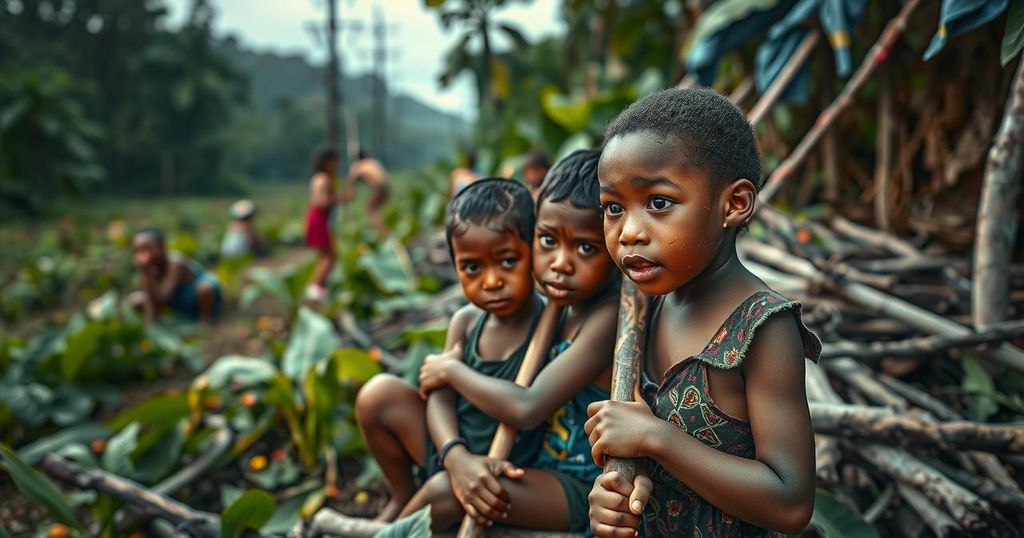Over 420,000 Children Face Crisis from Drought in Amazon: UNICEF Calls for Action

More than 420,000 children in the Amazon are affected by severe drought and water scarcity impacting Brazil, Colombia, and Peru, according to the UN. UNICEF has called for increased climate financing at COP29 to address the resulting food insecurity and healthcare accessibility issues. Officials reported significant school and clinic closures, while experts attribute these challenges to the ongoing El Niño phenomenon and broader climate crises.
According to the United Nations, over 420,000 children in the Amazon basin are currently suffering from alarming levels of drought and water scarcity impacting their daily lives. This severe drought, which has persisted since last year, is putting a strain on Indigenous and local communities across Brazil, Colombia, and Peru, who depend on waterways for transportation and access to resources. Ahead of the COP29 climate change summit in Baku, Azerbaijan, UNICEF has emphasized the urgent need for increased climate financing to protect vulnerable children affected by these environmental crises. Catherine Russell, the Executive Director of UNICEF, has articulated the devastating impact of the drought: “We are witnessing the devastation of an essential ecosystem that families rely on, leaving many children without access to adequate food, water, health care and schools.” The current water shortages threaten not only children’s health and nutrition but also the functionality of educational and medical infrastructure, thereby exacerbating food insecurity and increasing the risk of malnutrition. In Brazil, the drought has led to the closure of over 1,700 schools and approximately 760 medical facilities due to low river levels. Colombia’s Amazon has seen similar challenges, with 130 schools halting classes due to food and water shortages. To address these pressing needs, UNICEF is appealing for $10 million to support affected communities through water provision and health services. Meteorological assessments suggest that the ongoing El Niño climate phenomenon, coupled with broader climate change issues, is contributing to the drought in the Amazon region. This prolonged lack of rainfall has intensified forest fires and disrupted vital energy supplies, adversely affecting agricultural productivity and risking the health of both the populace and the ecosystem. Despite these setbacks, Brazilian Environment Minister Marina Silva expressed optimism that governmental measures can successfully combat climate change, citing a 30 percent reduction in deforestation in the past year—a sign of progress amid adversity. With the COP29 summit approaching, global leaders are encouraged to prioritize climate financing for children, recognizing the interconnection between environmental health and societal well-being. As underscored in recent reports, ensuring the health of the Amazon is not just vital for local populations but also for the planet as a whole.
The Amazon rainforest has faced unprecedented challenges due to climate change, marked by record droughts that have significantly impacted its ecosystem and the livelihoods of nearby communities. As a crucial natural resource, the health of the Amazon is tightly interlinked with water access, food security, and overall health standards for its inhabitants, particularly children. The UN and UNICEF are raising alarms as deteriorating environmental conditions threaten the welfare of hundreds of thousands of children across Brazil, Colombia, and Peru. The upcoming COP29 summit aims to address these pressing issues through enhanced international cooperation and funding support.
In summary, the ongoing drought in the Amazon basin has severely impacted the lives of over 420,000 children, leading to significant accessibility issues concerning food, water, education, and healthcare. The need for increased climate financing has never been more critical, as highlighted by UNICEF’s appeals ahead of COP29. Despite recent advances in combating deforestation, the urgency of addressing climate change and its effects on vulnerable populations remains paramount. Collaborative global efforts are essential to safeguard the future of these children and the Amazon ecosystem.
Original Source: www.aljazeera.com







